#laura ziskin
Text
"Columbia Acquires Rights to Develop Sci-Fi Action Film Based On Popular PC Game 'Deus Ex' for Producer Laura Ziskin. Columbia Pictures - 05/21/2002."
Apparently, a script was developed where JC said "shit" a lot
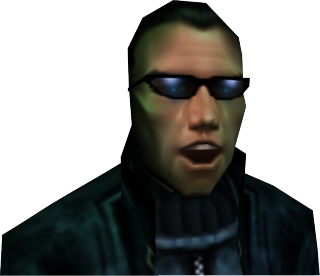
12 notes
·
View notes
Text

My Top 10 Columbia Pictures Movies (2024 Redo)
#10 Bad Boys for Life
#9 Pixels (2015 film)
#8 The Adventures of Tintin (film)
#7 The Angry Birds Movie
#6 The Angry Birds Movie 2
#5 Spider-Man (2002 film)
#4 Spider-Man: Into the Spider-Verse
#3 Smurfs: The Lost Village
#2 The Smurfs (film)
And #1 Arthur Christmas
Honorable Mentions: Cloudy with a Chance of Meatballs (film), Cloudy with a Chance of Meatballs 2, Surf's Up (film), Open Season, The Pirates! Band of Misfits, Hotel Transylvania, The Smurfs 2, Hotel Transylvania 2, Goosebumps, The Mitchells vs. the Machines, Wish Dragon, Vivo, Hotel Transylvania: Transformania, And Spider-Man: Across the Spider-Verse
Original Template: https://www.deviantart.com/jackskellington416/art/Top-10-Columbia-Pictures-Films-Meme-668220896
Bad Boys for Life Belo To Chris Bremner, Peter Craig, Joe Carnahan, 2.0 Entertainment, Overbrook Entertainment, Westbrook Inc. Jerry Bruckheimer Films Inc. Columbia Pictures Industries, Inc. Sony Pictures Releasing, Sony Pictures Entertainment Motion Picture Group, Sony Pictures Entertainment Inc. Sony Entertainment, Inc. Sony Corporation of America, And Sony Group Corporation
Pixels (2015 film) Belongs To Patrick Jean, Tim Herlihy, Timothy Dowling, Lone Star Global Acquisitions, Ltd. China Film Group Corporation, Film Croppers Entertainment, 1492 Pictures, Happy Madison Productions, Inc. Columbia Pictures Industries, Inc. Sony Pictures Releasing, Sony Pictures Entertainment Motion Picture Group, Sony Pictures Entertainment Inc. Sony Entertainment, Inc. Sony Corporation of America, And Sony Group Corporation
The Adventures of Tintin (film) Belongs To Hergé, Steven Moffat, Edgar Wright, Joe Cornish, Hemisphere Media Capital, The Kennedy/Marshall Company, WingNut Films Productions Ltd. Amblin Entertainment, Inc. Amblin Partners, LLC. Columbia Pictures Industries, Inc. Sony Pictures Releasing, Sony Pictures Entertainment Motion Picture Group, Sony Pictures Entertainment Inc. Sony Entertainment, Inc. Sony Corporation of America, Sony Group Corporation, Nickelodeon Movies, Paramount Pictures Corporation, And Paramount Global
The Angry Birds Movie Belongs To Mikael Hed, Mikko Pöllä, John Cohen, Jon Vitti, Rovio Animation, Ltd. Rovio Entertainment Corporation, SEGA Corporation, SEGA Sammy Holdings Inc. Columbia Pictures Industries, Inc. Sony Pictures Releasing, Sony Pictures Entertainment Motion Picture Group Sony Pictures Entertainment Motion Picture Group, Sony Pictures Entertainment Inc. Sony Entertainment, Inc. Sony Corporation of America, And Sony Group Corporation
The Angry Birds Movie 2 Belongs To Peter Ackerman, Eyal Podell, Jonathon E. Stewart, Rovio Animation, Ltd. Rovio Entertainment Corporation, SEGA Corporation, SEGA Sammy Holdings Inc. Sony Pictures Animation Inc. Columbia Pictures Industries, Inc. Sony Pictures Releasing, Sony Pictures Entertainment Motion Picture Group, Sony Pictures Entertainment Inc. Sony Entertainment, Inc. Sony Corporation of America, And Sony Group Corporation
Spider-Man (2002 film) Belongs To Stan Lee, Steve Ditko, David Koepp, Laura Ziskin Productions, MARVEL Entertainment, LLC, Columbia Pictures Industries, Inc. Sony Pictures Releasing, Sony Pictures Entertainment Motion Picture Group, Sony Pictures Entertainment Inc. Sony Entertainment, Inc. Sony Corporation of America, And Sony Group Corporation
Spider-Man: Into the Spider-Verse Belongs To Stan Lee, Steve Ditko, Phil Lord, Rodney Rothman, Pascal Pictures, Lord Miller Productions, Arad Productions Inc. MARVEL Entertainment, LLC, Sony Pictures Animation Inc. Columbia Pictures Industries, Inc. Sony Pictures Releasing, Sony Pictures Entertainment Motion Picture Group, Sony Pictures Entertainment Inc. Sony Entertainment, Inc. Sony Corporation of America, And Sony Group Corporation
Smurfs: The Lost Village Belongs To Pierre Culliford, Stacey Harman, Pamela Ribon, Lone Star Global Acquisitions, Ltd. Wanda Media Co., Ltd. Wanda Group, Wanda Culture Holding Co. Limited, Éditions Dupuis S.A. Kerner Entertainment Company, Sony Pictures Animation Inc. Columbia Pictures Industries, Inc. Sony Pictures Releasing, Sony Pictures Entertainment Motion Picture Group, Sony Pictures Entertainment Inc. Sony Entertainment, Inc. Sony Corporation of America, And Sony Group Corporation
The Smurfs (film) Belongs To Pierre Culliford, J. David Stem, David N. Weiss, Jay Scherick, David Ronn, Éditions Dupuis S.A. Kerner Entertainment Company, Sony Pictures Animation Inc. Columbia Pictures Industries, Inc. Sony Pictures Releasing, Sony Pictures Entertainment Motion Picture Group, Sony Pictures Entertainment Inc. Sony Entertainment, Inc. Sony Corporation of America, And Sony Group Corporation
Arthur Christmas Belongs To Peter Baynham, Sarah Smith, Aardman Animations Limited, Sony Pictures Animation Inc. Columbia Pictures Industries, Inc. Sony Pictures Releasing, Sony Pictures Entertainment Motion Picture Group, Sony Pictures Entertainment Inc. Sony Entertainment, Inc. Sony Corporation of America, And Sony Group Corporation
0 notes
Text
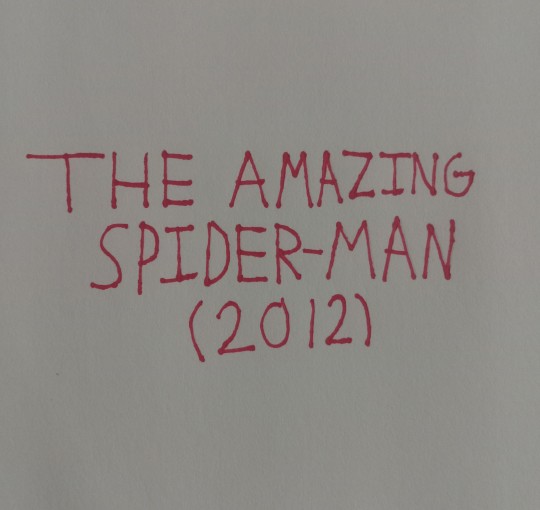
The Amazing Spider-Man (2012) Rewrite
Directed by Marc Webb
Screenplay by James Vanderbilt, Alvin Sargent, Steve Kloves, Me :3
Story by James Vanderbilt, Me :3
Based on The Amazing Spider-Man by Stan Lee and Steve Ditko
Produced by Laura Ziskin, Avi Arad, Matt Tolmach
Starring Andrew Garfield, Emma Stone, Rhys Ifans, Denis Leary, Cambell Scott, Irrfan Khan, Martin Sheen, Sally Field
Cinematography by John Schwartzman
Edited by Alan Edward Bell, Pietro Scalia
Music by James Horner
Production Companies: Colombia Pictures, Marvel Entertainment, Laura Ziskin Productions, Arad Productions Inc., Matt Tolmach Productions
Distributed by Sony Pictures Releasing
Release Dates: June 13, 2012 (United States) July 3, 2012 (Tokyo)
Running Time: 136 minutes
Country: United States
Language: English
Budget: $200-230 million
Box Office: $758 million
Act One:
We open on a cold and stormy night. It is 11:45 p.m. on May 3rd, 2002. We turn our attention to a small suburban house in Forest Hills, Queens, New York.
We cut to a boy, age 7, sitting on a staircase with his hands cupped over his eyes.
"3...2...1. Ready or not, here I come." The child says out loud. He lifts himself up off the staircase and walks into the living room.
He then notices a pair of shoes underneath the window sill curtain. He pulls back the curtain...and a broom with a fedora on top falls over next to the boy. The boy, with a dejected look on his face, searches the rest of the house for his father. He checks the closet of his room, nothing there, he checks in the garage, nothing there, until after standing in place in the middle of the house wondering where his father could be, the boy has a eureka moment, and decides to check his Dad's office.
Once he opens the door, he looks inside and notices papers strew out all over the floor. Documents...of some sort of....cure? Cure for what? And why are they researching.....
Spiders?
Suddenly, his Dad bursts in.
Richard Parker, age 51, looks down at Peter with an alarmed look on his face.
Richard: "Peter, what are you doing in my office?"
Peter: "I thought I would find you in here."
Richard: "Peter, I told you you aren't supposed to be in here. This is private work stuff."
Peter: "But I thought we were playing Hide 'n' Seek?"
Richard: "Not right now..."
Richard starts erasing equations written on a chalkboard and packing the scattered documents into a large suitcase.
Peter: "Where are you going?"
Richard: "Peter, your mother and I have to go away for a few weeks. We're gonna drop you off at your Uncle Ben and Aunt May's place for the time being."
Peter: "Dad, why can't I go with you?
Richard: "I told you, it's top secret, Peter. It could put you in danger."
Mary Parker, age 49, walks into the room.
Mary: "Richard, we have to leave. The plane leaves in half an hour."
Richard: "Okay, I'm almost ready, get the car started. We'll take Peter to Ben's place."
Mary takes Peter by the hand, and takes him to the car. Richard stuffs the suitcases in the trunk of the car and steps inside of the driver's seat, and started the engine. After a few miles of driving, they finally make it to the residence of Ben and May Parker.
When they get there, they hand Peter over to his Uncle and Aunt.
Ben: "Richard? What are you doing here this late at night?"
Richard: "There's no time to explain. Take good care of him, Ben, please."
Ben: "Of course."
Richard: "Thank God for you, Ben."
Mary: "Peter, I know this must be scary for you right now, but I promise you, everything will be alright."
Peter: "Okay, Mom."
Mary: "I love you more than anything else in this world, Peter. Please be good."
Peter: "I will, Mom."
Richard: "Honey, we have to leave."
Mary gives Peter one last kiss on the forehead, and gets in the car.
Richard says his final goodbyes to his son.
Richard: "I love you, Peter."
Peter, with tears in his eyes, says his final goodbyes to his father.
Richard: "We'll be back, Peter."
Richard shuts the door, gets in the car, and drives off with Mary.
Peter watches the car exit the driveway and disappear into the night. He is comforted by Ben and May. They remind him his parents will be back in a few weeks.
Little did Peter know, that would be the last time he would ever see his parents again.
1 note
·
View note
Text
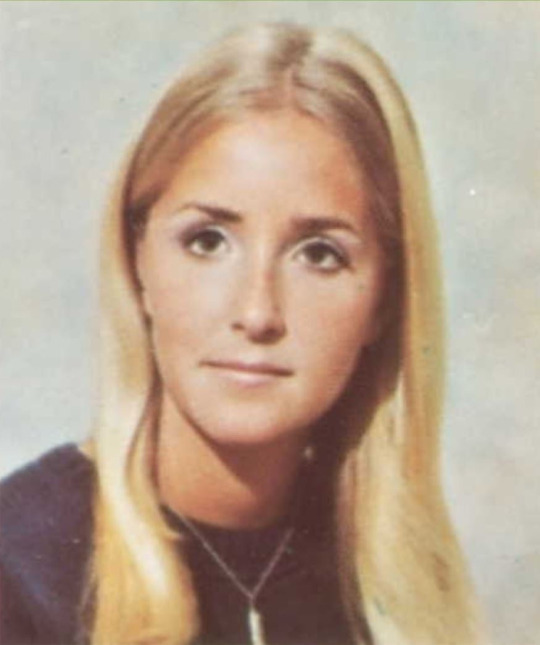

Carla Florencia the Show Runner hehe 🥹🥲🥰🥰
Laura Ziskin Rest In Peace #producersguildofamerica #pga #dreamers
0 notes
Photo





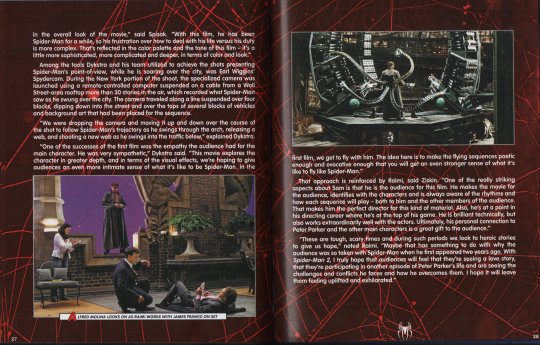
From the booklet which comes with the Spider-Man Trilogy Limited Edition Collection blu-ray!
This talks about the making of Spider-Man 2, here’s the bit about the first Spider-Man movie.
Click for a transcript:
THE EVOLUTION OF A SUPERHERO
“It was truly gratifying and even a bit overwhelming to witness how strongly moviegoers around the world reacted to Spider-Man,” said director Sam Raimi. “As a filmmaker, I always want people to really enjoy my movies, and on that level, Spider-Man exceeded my expectations.”
After the triumph of the first Spider-Man, Raimi knew he had a responsibility to follow it up with a story that justified the fans’ enthusiasm and their built-in expectations for the next adventure. “There’s great interest in this movie, following the success of the first one,” he acknowledged. “For the kids who come to see it, Spider-Man is their hero. So while the job of making this movie is to provide entertainment, it is also to create a story that shows them a moral character, someone who has to make tough choices and the right decisions in order to continue to be worthy of their admiration.”
The wealth of detailed stories and characters in the Spider-Man comic book series provided a mother lode from which to cull the plot for Spider-Man 2. “The Marvel artists and writers have done a great job through the decades – I know, because I’m a big fan myself – so there’s a tremendous amount of good material to draw upon,” noted Raimi. “Finding a storyline wasn’t that difficult. It was finding the right story, the one that made for a proper follow-up installment, and provided a logical progression for the audience and a logical growth for the character. For the, I relied on the terrific storytelling instincts of my very fine producers Laura Ziskin and Avi Arad. Together with the contributions of our great writers, we found a plot line with ideas that reverberated.”
With the storyline of the new adventure locked, Arad looked forward to the reunion of the Spider-Man filmmaking family, not the least of which was Tobey Maguire. “Tobey was so happy to be Spider-Man again and to be Peter Parker,” said Arad. “As an actor Tobey relished deepening the audience’s understanding of who Peter Parker is and who is becoming,” added Ziskin. “Peter’s a man who is transition, someone who’s struggling with the choices he is making.”
Maguire added, “The theme ‘with great power comes great responsibility’ is never lost on Peter. It’s difficult to be a young man and have to sacrifice as much as he has – presumably for the greater good – and to neglect his personal desires. The struggle continues here and it’s quite complicated, because Peter’s searching desperately for a way to achieve some balance in his life.”
As Peter becomes more immersed in his dilemma, it creates a rift between him and the important people in his life. Though his love for MJ is stronger than ever, she has moved on with her life, pursuing an acting career, living in Manhattan and moving in new social circles. “In this film, Peter is off in his own world and not a reliable presence in MJ’s life,” explained Kirsten Dunst. “She still loves him a great deal, so it has become painful for her to be around him. Though they’ve both done a lot of growing up in the past two years, at the same time, they’ve drifted apart.”
Then, as if Peter’s life were not complicated enough, the situation moves from bad to worse – much worse. Enter Doc Ock.
Dr. Otto Octavius (Alfred Molina) is a brilliant scientist whose life work has been dedicated to experiments utilizing fusion as a new source of energy. Charming, vibrant and energetic, Dr. Octavius is introduced to Peter by Harry Osborn.
“This movie is the story of Peter’s life, which is out of balance, and Dr. Octavius who, for Peter, represents someone who has achieved that balance,” explained Raimi.
“Peter sees Octavius as somebody who has mastered both his gifts – in this case science, through which he can serve the good of mankind, while also maintaining a personal life, a loving relationship with his wife Rosie (Donna Murphy). This leads Peter to the conclusion that it’s possible to have both.” Dr. Octavius, with the support of his wife, has been working diligently in his home laboratory, trying to perfect his groundbreaking fusion theory. But when a demonstration of his creation goes horribly wrong, Dr. Octavius undergoes a terrible transformation – evolving into the powerful, multi-tentacled Doc Ock.
In Spider-Man 2, the talented and versatile Molina brings this powerful adversary to terrifying life. “He is a formidable enemy for Spider-Man,” said Arad. “He can climb walls faster and better than Spider-Man. In fact, there’s nothing Spider-Man can do that Ock cannot counteract.”
Doc Ock, one of the most popular villains of the Spider-Man comic book series, first appeared in “The Amazing Spider-Man #3,” which was published in 1963. He immediately became one of Spider-Man’s most formidable foes. According to comic lore, each of Ock’s limbs can move at speeds of up to 90 feet per second and strike with the force of a jackhammer. The extremely powerful tentacles enable him to lift a vehicle off the ground, pulverize bricks, claw through concrete walls and hover above his victims by rising into the air.
The filmmakers were eager to attract Molina for the central role. “We needed someone who brought a palpable reality to the part, and who was also sincere, had a great sense of humor and personal warmth,” said Raimi. “Alfred is a brilliant actor, and what he’s brought so effectively to the character of Doc Ock is the sense of him as a misunderstood man who has turned into a beast.”
Molina confessed, “I’ve always been a Marvel Comic fan because their characters are so interesting. They have problems. They’re very realistic.” From him, the mechanics behind the role of Doc Ock was a true education. “It was mind-boggling, the breadth and the imagination that went into how each of my character’s actions – flying across the room, crashing through a plate glass window, smashing a taxicab – was to be executed. It’s a unique way of filming that’s not like anything most of us get to do really. It’s a very particular way of working, and absolutely fascinating.”
J.K. Simmons also returns in Spider-Man 2 as Peter’s gruff boss at the Daily Bugle, J Jonah Jameson. “I fire Peter several times in this movie. Every time I see him, I fire him,” laughed Simmons. “And then I re-hire him because there’s always some pressing need for his services.”
Principal photography on Spider-Man 2 began on April 12, 2003, in New York City, where the production spent approximately three weeks shooting at various locations in Manhattan, Queens and Brooklyn, as well as on a Yonkers stage. From ground-level street shots to rooftops high above the city, the filmmakers efficiently utilized the time they spent in New York, giving them the opportunity to expand on the city’s unique environment, which had lent such vibrancy to the first Spider-Man.
“In the first film we established New York as a character in the movie. With Spider-Man 2, we went even further,” said production designer Neil Spisak. “We used a lot more of the city, including [photographic] plates of real buildings and real streets. Improvements in technology over the past three years enabled [visual effects designer] John Dykstra and I to marry existing buildings to scenery buildings to CG buildings even better than the first time around. It’s a much more complete experience.”
“We got more of a feeling of New York in this movie,” added Ziskin. “The movie is being shot in widescreen, which is appropriate because this is a different story, so it required a different approach.”
Production began on the campus of Columbia University in uptown Manhattan, which served as the university Peter Parker attends while he struggles with the responsibilities of his academic workload and his superhero duties. The rooftop of the Hotel Intercontinental, across from the Waldorf Astoria, was the location where Spider-Man contemplates his next move, while downtown, in the Wall Street area, another rooftop served as the “launch-pad” for the Spydercam camera, as it dipped and swooped over several blocks to replicate one of Spider-Man’s high-stakes aerial journeys through the city.
“We executed one of the longest wire shots the Spydercam has ever done,” said executive producer Joseph M. Maracciolo. “The Wall Street shot was around 2,400 feet. I’m an ex New Yorker, so I didn’t find the location shoot particularly daunting. But there are always difficulties when you’re doing wire work in New York, including the placement of the cranes on the buildings, the movement of the cast, crew and equipment, and of course, the crowds.”
“It was a challenge for us to move our production to the tops of buildings, but we couldn’t have been happier, because rooftops are Spider-Man’s world and that is his view of the city as he swings through it,” noted co-producer Grant Curtis. “It was breathtaking to see the world from 70 stories up – a world unto itself. You can’t fully really appreciate the beautiful architecture of New York’s skyscrapers from ground level. We showed some of that in the first film, but we wanted to show more of Spider-Man’s vertiginous world, and I think we really captured that with this film.”
In Spider-Man 2, Doc Ock sweeps Aunt May off her feet – literally – and takes her up several stories of a tall building. Rosemary Harris performed her stunts in a variety of harnesses, but only after she had managed to talk the filmmakers into letting her give her stunt double a rest. “I was a bit miffed at first, because my wonderful stunt double was going to do a lot of these harness maneuvers,” recalled Harris. “So I asked Sam and Laura, ‘Why not let me have a go at it?’ At first they were reluctant. But I begged them to at least let me try and they finally relented.”
Returning to Los Angeles, Spider-Man 2 shot on several stages on the Sony Pictures Studios lot in Culver City. Stage 15 was home to the Daily Bugle offices, as well as Peter’s tiny apartment and Dr. Octavius’ elaborate home laboratory. On Stage 29, the Osborn mansion, where Harry Osborn now lives, was recreated. Stage 27 housed MJ’s apartment set, a giant spider web, the interior of the Planetarium, the massive clock tower set as well as various other set pieces. A series of elevated trains were built on Stage 14, where Spider-Man and Doc Ock match wits.
One of the most elaborate sets for Spider-Man 2 was the pier set, designed by Spisak and built over the course of 15 weeks on Soundstage 30. “In contrast to Dr. Octavius’ lab, which was part of his apartment – a streamlined, organized and clean space – the pier is a maniacal, decaying, decrepit space,” explained Spisak. “It follows his character development in terms of his becoming a wilder, more dangerous and more formidable adversary for Spider-Man.”
The set, approximately 60 feet wide by 120 feet long and 40 feet tall, was constructed over a water tank and enhanced by several different components, including CG/plate work and miniatures.
“Before we built the set, we created an exact ¾ scale model of it, about 7 feet long and 4 feet wide, from drawings and blueprints. The model was extremely useful to the carpenters, who could take measurements to help them construct the full-sized pier, as well as for the miniatures team, so they could ascertain the dimensions, textures and materials that were used,” explained art director Tom Wilkins. “We shot plates down in San Pedro, where we panned from a real pier to the water. In post-production a New York background was added. We also built a miniature pier – interiors and exteriors – to complete the composition on the East River.” The art department team designed a 136 foot by 40 foot-high vinyl backing to represent Ock’s view of Manhattan through a large window at the end of the pier set. Wave machines were rigged in the water to create movement under the pier.
The production then moved to the Universal backlot for two weeks of shooting. Several city streets were transformed into a variety of New York neighborhoods including the exterior of the Lyric Theatre where MJ performances in an off-Broadway production of Oscar Wilde’s The Importance of Being Earnest. Ari’s Village Deli and Bakery became the site of an extremely complex scene involving a quiet conversation between Peter and MJ, which is interrupted by Peter’s “spider sense” – and a car careening through the plate glass window, followed by the arrival of Doc Ock.
“It was a great luxury to be able to build that set from every aspect, so that we could do everything we needed for the scene,” said Spisak. “The walls were made of french plate so that when the car smashed through it, the buildings around it were protected. We were able to design what we thought it should look like visually, then as tricks, gags and stunts became clearer, we were able to add them to the set before it was completely finished.”
“The deli was a full, 360 degree set, with a kitchen, deli counters, pastries, ceiling fans and chandeliers,” added art director Steve Saklad, who worked closely with Spisak. “We dressed the exterior streets so that you could look out of the window and see the intersection of Lafayette Street and Astor Place. It required an enormous amount of signage, billboards, street dressing, trees and traffic lights.”
For Raimi, “The diner was a complex technical scene, because it brought together so many different departments, each relying on the other to fulfil their function and communicate with each other so that each individual shot would work. We utilized mechanical effects and the stunt department had to take an automobile, spin it and flip it through the deli window, with the prop department providing the breakaway items. What made it even more complex was that we had to fly Doc Ock in, using something we dubbed the “walk rig.”
The “walk rig” was created for Doc Ock, because the character not only moves himself, but his tentacles move him around as well. When he walks on the tentacles, they support his weight, so a device was constructed to harness him and move him through space as if the tentacles were supporting him. The visual effects department also created “virtual” tentacles where practical ones weren’t feasible.
When he was in full costume, Molina’s tentacles weighed between 75 to 100 pounds, depending upon the action required for the scene. Each of the tentacles was fully articulated. In their expanded, 13-foot length, each upper tentacle consisted of approximately 76 individual pieces Each vertabra was handmade, hand molded, sanded, individually hand painted, chromed, then painted again and assembled by hand. The entire collection of Doc Ock tentacles, bases, heads and wrists, if laid end to end, would be taller than a 20-story building.
Academy Award winning costume designer James Acheson welcomed the opportunity to further explore and improve upon the already classic Spider-Man costume for Spider-Man 2. “Creating the Spider-Man suit for the first film was a real challenge since we were designing for a kind of Cirque du Soleil acrobat, someone who had a unbelievable kinetic spiraling ability,” he said. “So the suit had to be extremely flexible. For the new installment we made several improvements, though you’d have to be a real enthusiast to spot them. The colors are slightly different, and we have made subtle changes in terms of the movement inside the costume’s hood. We also adjusted the eyepieces of Spider-Man’s mask as well as certain aspects of the spider design on the front and the back of the suit.”
For Spider-Man 2’s Doc Ock, Acheson and Raimi spent close to a year collaborating with Spisak and visual effects designer John Dykstra and working with Edge FX in what began as a series of “group think” sessions, according to Raimi. “I needed John Dykstra’s input, because it was John who was going to have to handle Doc Ock’s movements in CG, so he had to be involved in designing the character, along with Jim, who was going to determine the look of the character,” recalled Raimi. “Part of the look determined the movement, and what the arms look like began to govern how it functioned. Neil was involved because Ock had to be a part of Neil’s world in the film. A great interdependence developed among the department heads in order to achieve the complex nature and physicality of the character,”
“The challenge with Doc Ock is to visually create a believable world, focusing on a man with four tentacles growing out of his back,” said Spisak. “Now, that can be a tough swallow. So, in creating Ock and his world, we needed to design and play it so that everything was credible. Ove the course of several months, it became clear what was physically possible for Ock and what would have to be achieved via CG. We conceptualized the look and only then did we deal with the physical limitations, rather than letting them stop us at the beginning.”
Added Dykstra: “It was a huge challenge to make Doc Ock come to life. His tentacles had to meet several criteria. They had to be appropriate with regard to the world Neil had created for Spider-Man and Ock. The components of the costume – the texture and the weight – had to bed something an actor could actually wear. Since using the tentacles wasn’t always practical, we had to create ‘virtual’ versions with Edge FX. In the end, integrating the tentacles into the story was a marriage of all those components and the collaboration of everyone involved.”
Spisak and his team designed and dressed more than 100 sets and locations for Spider-Man 2. “There are probably 10 enormous sets, while some are simply street corners. We covered eleven blocks in downtown Los Angeles and used many rooftops, streets and buildings in New Yorj City,” noted Spisak. “This is certainly the biggest film I’ve ever done.”
Spisak worked with director of photography Bill Pope on the color palette for the sets, and they pored over research and location pictures to inspire them for the story’s lighting requirements. “In the first film, Peter Parker was younger, less aware and just beginning to discover his new powers. That was reflected in the overall look of the movie,” said Spisak. “With this film, he has been Spider-Man for a while, so his frustration over how to deal with his life versus his duty is more complex. That’s reflected in the color palette and the tone of this film – it’s a little more sophisticated, more complicated and deeper, in terms of color and look.”
Among the tools Dykstra and his team utilized to achieve the shots presenting Spider-Man’s point-of-view, while he is soaring over the city, was Earl Wiggins’ Spydercam. During the New York portion of the shoot, the specialized camera was launched using a remote-controlled computer suspended on a cable from a Wall Street-area rooftop more than 30 stories in the air, which recorded what DSpider-Man saw as he swung over the city. The camera traveled along a line suspended over four blocks, dipping down into the street and over the tops of several blocks of vehicles and background art that had been placed for the sequence.
“We were dropping the camera and moving it up and down over the course of the shot to follow Spider-Man’s trajectory as he swings through the arch, releasing a web, and shooting a new web as he swings into the traffic below,” explained Dykstra.
“One of the successes of the first film was the empathy the audience had for the main character. He was very sympathetic,” Dykstra said, “This movie explores the character in greater depth, and in terms of the visual effects, we’re hoping to give audiences an event more intimate sense of what it’s like to be Spider-Man. In the first film, we get to fly with him. The idea here is to make the flying sequences poetic enough and evocative enough that you will get an even stronger sense of what it’s like to fly like Spider-Man.”
That approach is reinforced by Raimi, said Ziskin, “One of the really striking aspects about Sam is that he is the audience for this film. He makes the movie for the audience, identifies with the characters and is always aware of the rhythms and how each sequence will play – both to him and the other members of the audience. That makes him the perfect director for this kind of material. Also, he’s at a point in his directing career where he’s at the top of his game. He is brilliant technically, but also works extraordinarily well with the actors. Ultimately, his personal connection to Peter Parker and the other main characters is a great gift to the audience.”
“These are tough, scary times and during such periods we look to heroic stories to give us hope,” noted Raimi. “Maybe that has something to do with why the audience was so taken with Spider-Man when he first appeared two years ago. With Spider-Man 2, I truly hope that audiences will feel that they’re seeing a love story, that they’re participating in another episode of Peter Parker’s life and are seeing the challenges and conflicts he faces and how he overcomes them. I hope it will leave them feeling uplifted and exhilarated.”
#spider-man#spider-man 2#sam raimi#avi arad#laura ziskin#tobey maguire#kirsten dunst#alfred molina#rosemary harris#jk simmons#interviews#behind the scenes#concept art#peter parker#aunt may parker#mary jane watson#doc ock#j jonah jameson#set design
93 notes
·
View notes
Photo
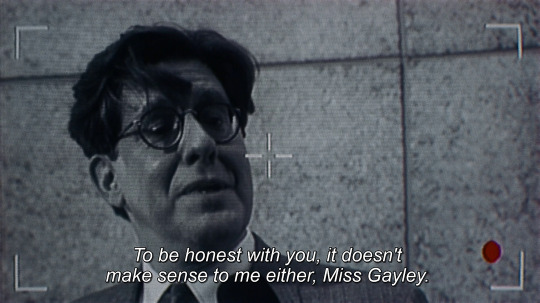
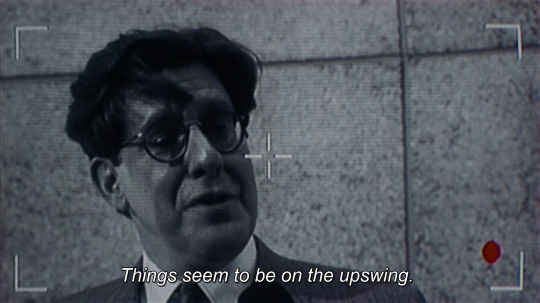
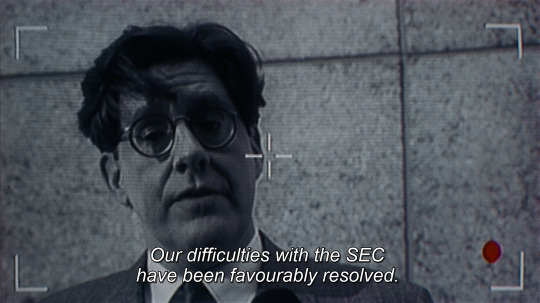
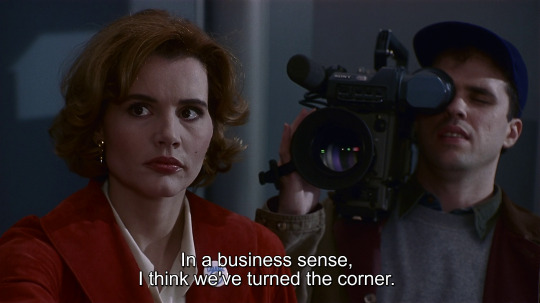

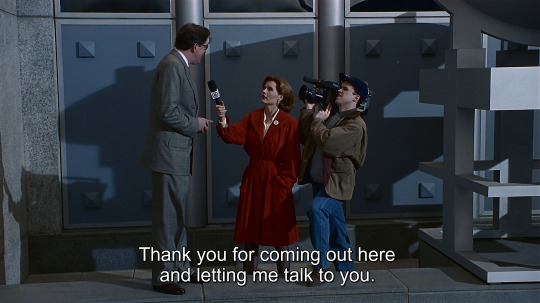
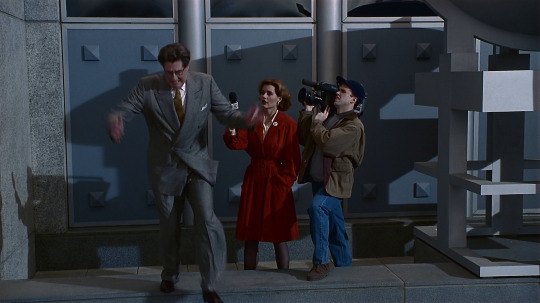

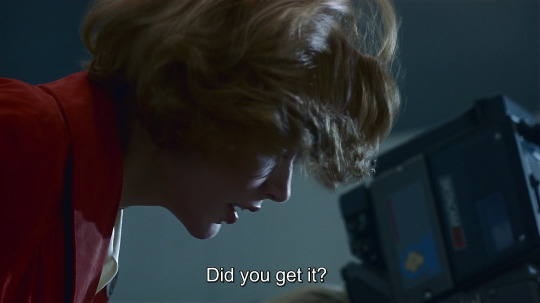

Hero (Stephen Frears, 1992).
#hero (1992)#stephen frears#laura ziskin#alvin sargent#david webb peoples#geena davis#kevin j. o'connor#oliver stapleton#mick audsley#dennis gassner#leslie mcdonald#nancy haigh#richard hornung
26 notes
·
View notes
Photo
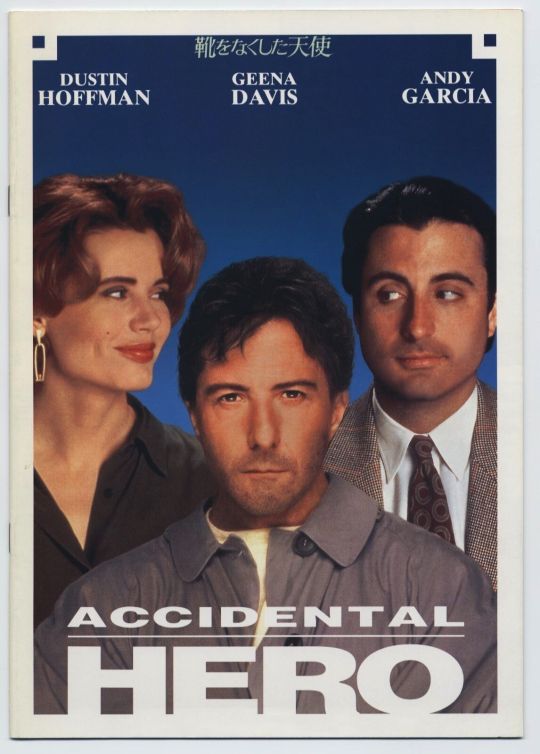


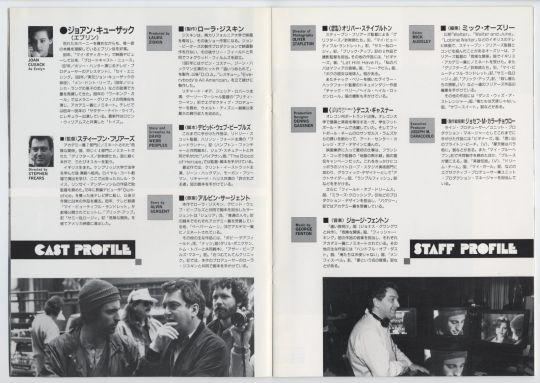
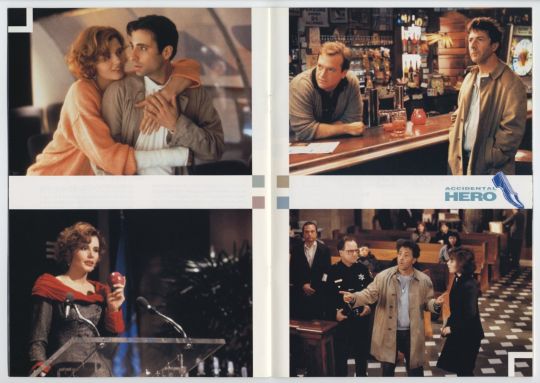

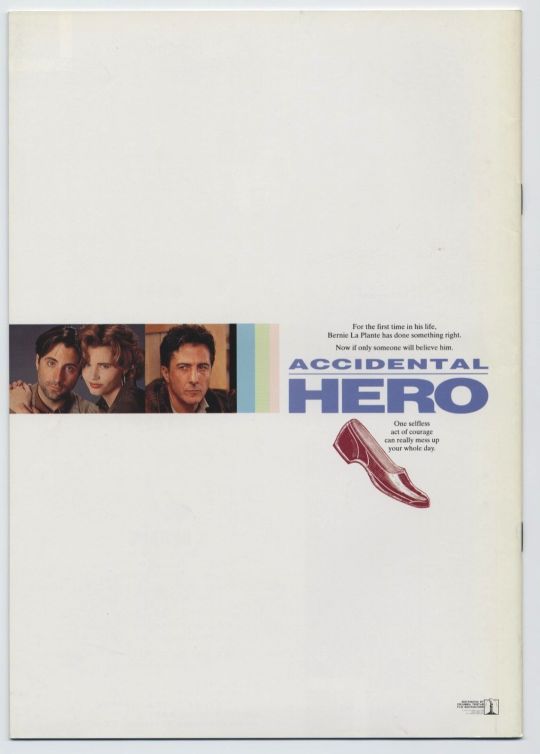
#Hero 1992#Accidental Hero#Dustin Hoffman#Geena Davis#Andy Garcia#James Madio#Joan Cusack#Stephen Frears#Laura Ziskin#Alvin Sargent#David Webb Peoples#90s
9 notes
·
View notes
Photo
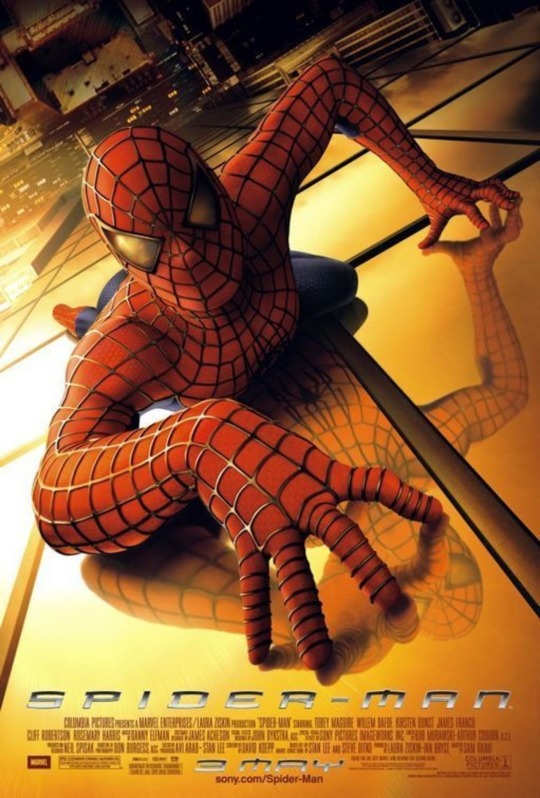
Sam Raimi’s Spider-Man hit theaters nationwide on May 3, 2002. Happy 20th anniversary!
#Spider Man#Spider Man 2002#Spider Man movie#Spiderman#Sami Raimi#Tobey Maguire#Willem Dafoe#Kirsten Dunst#James Franco#Cliff Robertson#Rosemary Harris#Marvel#Columbia Pictures#Marvel Enterprises#Laura Ziskin Productions#Sony Pictures#Sony Pictures Releasing#film#live action#live action film#anniversary#film anniversary
73 notes
·
View notes
Photo


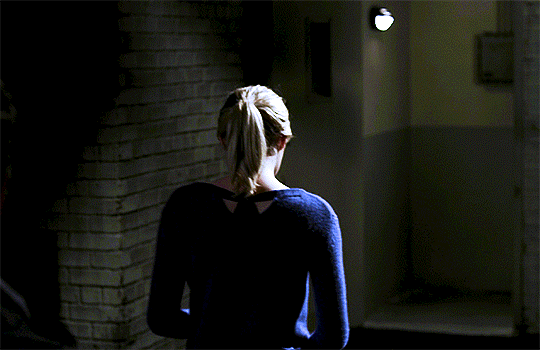


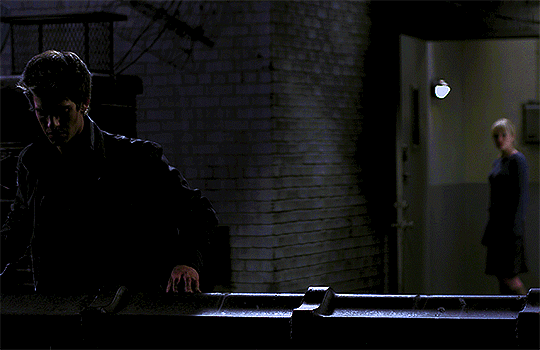


AA: The “I’m in trouble” thing is actually something that happened to Laura Ziskin [a posthumous producer on The Amazing Spider-Man] in real life when she met the great Alvin Sergeant, and in her memory. It was just great to use this line, because it’s the realization - that you kind of made a commitment. You’re falling in love and there’s -
MW: There’s no stopping it.
AA: So this is right out of real life experience.
THE AMAZING SPIDER-MAN (2012) commentary by dir. Marc Webb & producer Avi Avrad
#tasmedit#cinemapix#usermaya#userannalise#useryoumna#tusermeghan#usercy#userksena#sallysimpsons#tusercarol#filmedit#fyeahmarvel#usersawah#userstream#usersadie#tasm#userclo#myedit#movies#pwendolyn#i've thought about this every fucking day#since i first heard it#commentary
428 notes
·
View notes
Note
You got an anon a bit ago that mentioned hating Raimiverse!MJ and honestly I’m so on the fence about it. The way her character was written was absolutely HORRIBLE, but every once in a while you kinda get a glimpse into who Kirsten Dunst wanted her to be, and it makes me like, completely unable to hate her. Secret good MJ that lives in mine and Kirsten Dunst’s minds, I’m in love with you.
I think kirsten dunst knew the character lacking the way she was written, bc (from the imdb trivia page) "Laura Ziskin asked Kristen Dunst if she thinks Mary Jane knows who Spider-Man is in the scene when he rescues her in the alleyway, something about Peter and Spider-Man both saying a line about being "in the neighborhood." "No," says Dunst, "I don't think MJ's that bright"
Its interesting to imagine what version of mj we could have gotten
41 notes
·
View notes
Text
Murphy's Romance (1985)
Murphy's Romance by #MartinRitt starring #JamesGarner and #SallyField, who "can be just as captivating in a lighthearted project, perpetually in command despite the script never drawing her into any unpleasant crises", Now reviewed on MyOldAddiction.com
MARTIN RITT
Bil’s rating (out of 5): BBBB.5
USA, 1985. Columbia Pictures, Delphi IV Productions, Fogwood Films. Screenplay by Harriet Frank Jr., Irving Ravetch, based on the novella by Max Schott. Cinematography by William A. Fraker. Produced by Laura Ziskin. Music by Carole King. Production Design by Joel Schiller. Costume Design by Joe I. Tompkins. Film Editing by Sidney Levin.
Reuniting with…
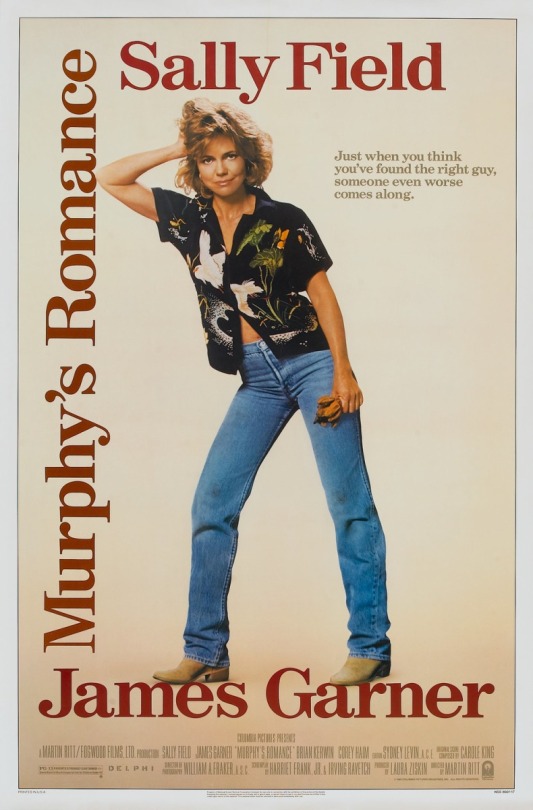
View On WordPress
#Academy Award 1985#Anna Thomson#Art Royer#Billy Ray Sharkey#Brian Kerwin#Bruce French#C. Ray Cook#Carole King#Charles Lane#Columbia Pictures#Corey Haim#Delphi IV Productions#Dennis Burkley#Dortha Duckworth#Drasha Meyer#Eugene Cochran#Fogwood Films#Gene Blakely#Georgann Johnson#Golden Globe 1985#Harriet Frank Jr.#Henry Slate#Hugh Burritt#Irving Ravetch#James Garner#Joe I. Tompkins#Joel Schiller#John C. Becher#John Higgenbotham#Johnny Ray Anthony
3 notes
·
View notes
Video
vimeo
Digital Blog Post
Work Cited
Amazon.co.uk: Stan Lee, Larry Lieber, Fred Kida: 9781631406515: Books. “The Amazing Spider-Man: The Ultimate Newspaper Comics Collection” Volume 3 (1981-1982) (Spider-Man Newspaper Comics): Amazon.co.uk: Stan Lee, Larry Lieber, Fred Kida: 9781631406515: Books.
Chen, Angela. “An Economist Explains What Digital Technology Means for the Future of Popular Culture.” The Verge. January 04, 2019.
“Feast of the Transfiguration of the Lord.” L'Oratoire Saint-Joseph Du Mont-Royal.
Forbes, Bruce David, and Jeffrey H. Mahan. Religion and Popular Culture in America, Third Edition. University of California Press, 2017.
Godard, Jean-Luc. “Breathless”. Tumblr. Retrieved from https://giphy.com/gifs/mirror-breathless-jean-luc-godard-vUOsfUyV60j84
Harris, Jennifer, RLG233 lecture, Superheroes, 01/24/2019.
Ivetteromero. “Whither the Caribbean: Stuart Hall's Intellectual Legacy.” Repeating Islands. May 10, 2017.
Lin, Jin Jacqueline. “Streaming Mass Media”. Linjacqueline. Retrieved from https://giphy.com/gifs/netflix-future-mX9oV8unFR1QTbmFa6
Lopez, Perez Ana. “Watching Tv Binge Watching Gif”. Vimeo. Retrieved from https://giphy.com/gifs/color-fish-26FKVlQRFXEWEiD96
Marston, George. “AXEL ALONSO Out, CB CEBULSKI In As Marvel Editor-in-Chief.” Newsarama.
Matadeen, Renaldo. “Into the Spider-Verse Pays Fitting Tribute to Stan Lee & Steve Ditko.” CBR. December 16, 2018.
Noone, Lucy. "Spiderman Is Jesus.”
Rainaldi, Andrew. “Saint Peter Parker: Christian Allegory in Superhero Movies.” Pop Cultural Studies. April 14, 2017.
“Religion and Popular Culture.” Stitcher.
Schudel, Matt. “Steve Ditko: Spider-Man Co-creator and Legend of Marvel Comics.” The Independent. July 12, 2018.
Spider-Man. Directed by Sam Raimi. Columbia Pictures, Marvel Enterprises, Laura Ziskin Productions, 2002.
“Spider-Man.” IMDb. May 01, 2002.
“The Amazing Spider-Man: The Ultimate Newspaper Comics” Collection Volume 3 (1981-1982) (Spider-Man Newspaper Comics)
“Spider-jesus.” DeviantArt.
“Transfiguration of Jesus Christ.” AllAboutJesusChrist.org.
Unmasking the Spirituality of Spider-Man. http://www.cinemaspirit.info/spiderman.htm.
1 note
·
View note
Photo
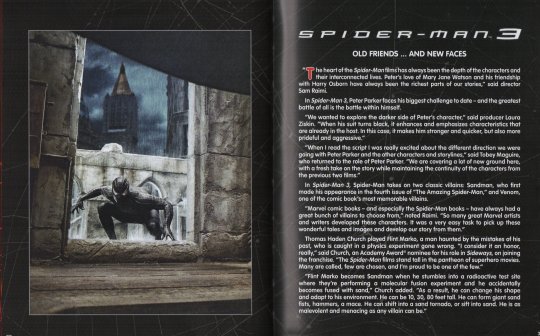
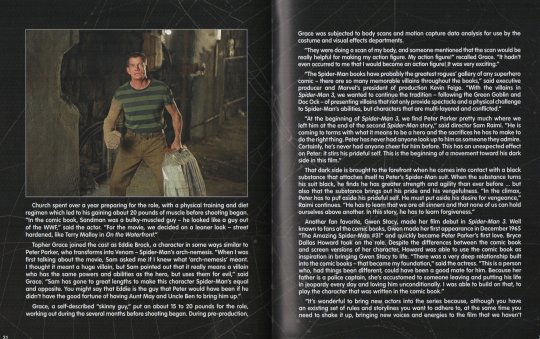

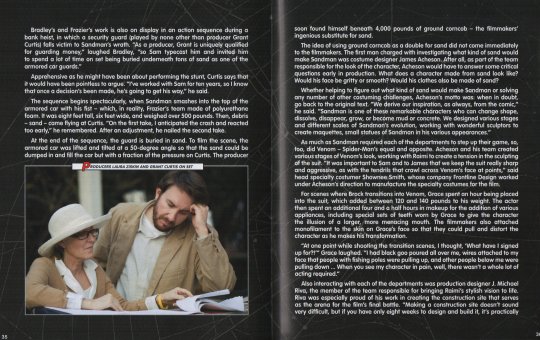

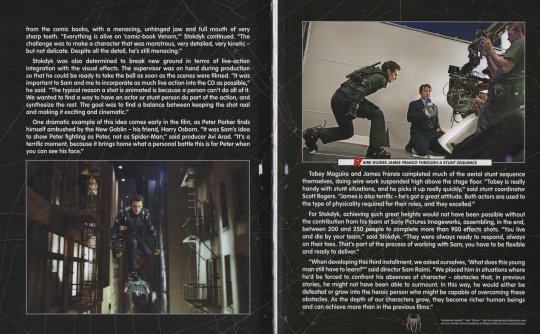
From the booklet which comes with the Spider-Man Trilogy Limited Edition Collection blu-ray!
This talks about the making of Spider-Man 3, here’s the bit about the first Spider-Man movie and here’s the bit about Spider-Man 2.
Click for a transcript:
OLD FRIENDS… AND NEW FACES
“The heart of the Spider-Man films has always been the depth of the characters and their interconnected lives. Peter’s love of Mary Jane Watson and his friendship with Harry Osborn have always been the richest parts of our stories,” said director Sam Raimi.
In Spider-Man 3, Peter Parker faces his biggest challenge to date – and the greatest battle of all is the battle within himself.
“We wanted to explore the darker side of Peter’s character,” said producer Laura Ziskin. “When his suit turns black, it enhances and emphasizes characteristics that are already in the host. In this case, it makes him stronger and quicker, but also more prideful and aggressive.”
“When I read the script I was really excited about the different direction we were going with Peter Parker and the other characters and storylines,” said Tobey Maguire, who returned to the role of Peter Parker. “We are covering a lot of new ground here, with a fresh take on the story while maintaining the continuity of the characters from the previous two films.”
In Spider-Man 3, Spider-Man takes on two classic villains: Sandman, who first made his appearance in the fourth issue of “The Amazing Spider-Man” and Venom, one of the comic book’s most memorable villains.
“Marvel comic books – and especially the Spider-Man books – have always had a great bunch of villains to choose from,” noted Raimi. “So many great Marvel artists and writers developed these characters. It was a very easy task to pick up these wonderful tales and images and develop our story from them.”
Thomas Haden Church played Flint Marko, a man haunted by the mistakes of his past, who is caught in a physics experiment gone wrong. “I consider it an honor, really,” said Church, an Academy Award nominee for his role in Sideway, on joining the franchise. “The Spider-Man films stand tall in the pantheon of superhero movies. Many are called, few are chosen, and I’m proud to be one of the few.”
“Flint Marko becomes Sandman when he stumbles into a radioactive test site where they’re performing a molecular fusion experiment and he accidentally becomes fused with sand,” Church added. “As a result, he can change his shape and adapt to his environment. He can be 10, 30, 80 feet tall. He can form giant sand fists, hammers, a mace. He can shift into a sand tornado, or sift into sand. He is as malevolent and menacing as any villain can be.”
Church spent over a year preparing for the role, with a physical training and diet regimen which led to his gaining about 20 pounds of muscle before shooting began. “In the comic book, Sandman was a bulky-muscled guy – he looked like a guy out of the WWF,” said the actor, “For the movie, we decided on a leaner look – street hardened, like Terry Malloy in On the Waterfront.”
Topher Grace joined the cast as Eddie Brock, a character in some ways similar to Peter Parker, who transforms into Venom – Spider-Man’s arch-nemesis. “When I was first talking about the movie, Sam asked me if I knew what ‘arch-nemesis’ meant. I thought it meant a huge villain, but Sam pointed out that it really means a villain who has the same powers and abilities as the hero, but uses them for evil,” said Grace. “Sam has gone to great lengths to make this character Spider-Man’s equal and opposite. You might say that Eddie is the guy that Peter would have been if he didn’t have the good fortune of having Aunt May and Uncle Ben to bring him up.”
Grace, a self-described “skinny guy,” put on about 15 to 20 pounds for the role, working out during the several months before shooting began. During pre-production, Grace was subjected to body scans and motion capture data analysis for use by the costume and visual effects departments.
“They were doing a scan of my body, and someone mentioned that the scan would be really helpful for making my action figure. My action figure!” recalled Grace. “It hadn’t even occurred to me that I would become an action figure! It was very exciting.”
“The Spider-Man books have probably the greatest rogues’ gallery of any superhero comic – there are so many memorable villains throughout the books,” said executive producer and Marvel’s president of production Kevin Feige. “With the villains in Spider-Man 3, we wanted to continue the tradition – following the Green Goblin and Doc Ock – of presenting villains that not only provide spectacle and a physical challenge to Spider-Man’s abilities, but characters that are multi-layered and conflicted.”
“At the beginning of Spider-Man 3, we find Peter Parker pretty much where we left him at the end of the second Spider-Man story,” said director Sam Raimi. “He is coming to terms with what it means to be a hero and the sacrifices he has to make to do the right thing. Peter has never had anyone look up to him as someone they admire. Certainly, he’s never had anyone cheer for him before. This has an unexpected effect on Peter: it stirs up his prideful self. This is the beginning of a movement toward his dark side in this film.”
That dark side is brought to the forefront when he comes into contact with a black substance that attaches itself to Peter’s Spider-Man suit. When the substance turns his suit black, he finds he has greater strength and agility than ever before… but also the substance brings out his pride and his vengefulness. “In the climax, Peter has to put aside his prideful self. He must put aside his desire for vengeance,” Raimi continues. “He has to learn that we are all sinners and that none of us can hold ourselves above another. In this story, he has to learn forgiveness.”
Another fan favorite, Gwen Stacy, made her film debut in Spider-Man 3. Well known to fans of the comic books, Gwen made her first appearance in December 1965 “The Amazing Spider-Man #31” and quickly became Peter Parker’s first love. Bryce Dallas Howard took on the role. Despite the differences between the comic book and screen versions of her character, Howard was able to use the comic book as inspiration in bringing Gwen Stacy to life. “There was a very deep relationship built into the comic books – that became my foundation,” said the actress. “This a person who, had things been different, could have been a good mate for him. Because her father is a police captain, she’s accustomed to someone leaving and putting his life in jeopardy every day and loving him unconditionally. I was able to build on that, to play the character that was written in the comic book.”
“It’s wonderful to bring new actors into the series because, although you have an existing set of rules and storylines you want to adhere to, at the same time you need to shake it up, bringing new voices and energies to the film that we haven’t experiences before, “noted Raimi. “It gives the audience a new experience, with the characters they love, but with a new energy dynamic, with those new faces on screen with them.”
“In terms of logistics and scope, Spider-Man 3 is by far the largest of the three films,” said Ziskin. “Sam has really upped the ante for this film, in terms of action sequences and visual effects involving Sandman and Venom, so it is a gigantic endeavor, with over 1,000 people working towards that goal.”
During production, Raimi relied on key members of his filmmaking team to bring to life before the cameras as much of Peter Parker’s story as possible. “Whenever it’s safe and practical, I like to capture the action in camera,” said Raimi. “Visual effects are an amazing tool for action that human beings can’t do – but if a human being can do it, let’s do it.”
The talented team of stuntmen was ready, but so was the cast. Bryce Dallas Howard, especially, surprised the filmmakers by being game for anything they could throw at her. At one point, the actress found herself hanging from a harness.
After performing several portions of the sequence on soundstages in Los Angeles, Howard was eager to get in the harness again to fly with Spider-Man over Sixth Avenue. “What’s so great about movies is you get to really experience these crazy, crazy stunts, things that you would never emerge from alive in real life,” says Howard. “I knew I would be 100% safe because Sam and the stunt team really protect the actors. So I tried to do as many things as possible, because it’s really fun and a great adrenaline rush!”
Thomas Haden Church was also up to the challenge – in fact, even more so. Whether it was being yanked five feet in the air so he could do a face-plant in the mud, or being chased (and caught) by dogs, or dangling off the side of a set, or falling onto train tracks, or having his face smashed into a pane of Plexiglas, the actor found himself bruised and battered repeatedly, but was ready for anything. According to producer Grant Curtis, “It wasn’t intentional, but it seemed sometimes like if any actor was required to get beat up in any way, Thomas was always drawing that short straw.”
Two members of the production team that played key roles in ensuring that these action sequences were both as safe and as spectacular as possible were special effects supervisor John R. Frazier (who previously served in the same capacity on the first two Spider-Man films) and second unit director Dan Bradley (a veteran of Spider-Man 2). “Working with Sam is like going back to school,” said Frazier. “You have that moment where you say, ‘Oh, this is going to be really, really hard, but a lot of fun.’ It’s not unusual for me to be on a movie like Spider-Man 3 for nine months, from the beginning planning stages through production.”
One scene that highlights their work is the Subway Drain portion of an elaborate fight sequence between Spider-Man and Sandman. Raimi worked closely with Frazier, Bradley and visual effects supervisor Scott Stokdyk on the sequence, in which Sandman is blasted by the force of a burst water pipe and, quite literally, goes down the drain. Sam wanted Sandman to melt away, in essence, during this sequence.
“This is the largest water gag for one shot I’ve ever done for a film,” recalled Frazier, who had previously supervised the special effects for Poseidon. “We used 50,000 gallons of water, shooting out of a pipe which blasted the rear of the set fifty feet away. When you see this sequence, the water appears to be a six-foot-thick column of water; however, we made the center of the pipe hollow, and used a restrictor plate to control the size of the column of water. The water is recirculated using pumps, which are able to pump 3,000 gallons a minute. We can fill both tanks in about five minutes, so that we are ready for another take.”
The sequence was covered using eight cameras, according to Stokdyk. “This sequence is where Spider-Man discovers Sandman’s weakness – water. We had to put a CG Sandman in here because the velocity of the water is too great to have Thomas Haden Church or a stuntman perform portions of the sequence. Water is a huge challenge for visual effects, especially on a large scale, so our goal here was to seamlessly integrate the elements for the sequence between practical and CG.”
Bradley and Frazier’s work is also on display in an action sequence during a bank heist, in which a security guard (played by none other than producer Grant Curtis) falls victim to Sandman’s wreath. “As a producer, Grant is uniquely qualified for guarding money,” laughed Bradley, “so Sam typecast him and invited him to spend a lot of time on set being buried underneath tons of sand as one of the armored car guards.”
Apprehensive as he might have been about performing the stunt, Curtis says that it would have been pointless to argue. “I’ve worked with Sam for ten years, so I know that once a decision’s been made, he’s going to get his way,” he said.
The sequence begins spectacularly, when Sandman smashes into the top of the armored call with his fist – which, in reality, Frazier’s team made of polyurethane foam. It was eight feet tall, six feet wide, and weighed over 500 pounds. Then, debris – sand – came flying at Curtis. “On the first take, I anticipated the crash and reacted too early,” he remembered. After an adjustment, he nailed the second take.
At the end of the sequence, the guard is buried in sand. To film the scene, the armored car was lifted and tilted at a 50-degree angle so that the sand could be dumped in and fill the car but with a fraction of the pressure on Curtis. The producer soon found himself beneath 4,000 pounds of ground corncob – the filmmakers’ ingenious substitute for sand.
The idea of using ground corncob as a double for sand did not come immediately to the filmmakers. The first man charged with investigating what kind of sand would make Sandman or solving any number of other costuming challenges, Acheson’s motto was: when in doubt, go back to the original text. “We derive our inspiration, as always, from the comic,” he said. “Sandman is one of those remarkable characters who can change shape, dissolve, disappear, grow, or become mud or concrete. We designed various stages and different scales of Sandman’s evolution, working with wonderful sculptors to create maquettes, small statues of Sandman in his various appearances.”
As much as Sandman required each of the departments to step up their game, so, too, did Venom – Spider-Man’s equal and opposite. Acheson and his team created various stages of Venom’s look, working with Raimi to create a tension in the sculpting of the suit. “It was important to Sam and to James that we keep the suit really sharp and aggressive, as with the tendrils that crawl across Venom’s face at points,” said head specialty costumer Shownee Smith, whose company Frontline Design worked under Acheson’s direction to manufacture the specialty costumes for the film.
For scenes where Brock transitions into Venom, Grace spent an hour being placed into the suit, which added between 120 and 140 pounds to his weight. The actor then spent an additional four and a half hours in makeup for the addition of appliances, including special sets of teeth worn by Grace to give the character the illusion of a larger, more menacing mouth. The filmmakers also attached monofilament to the skin on Grace’s face so that they could pull and distort the character as he makes his transformation.
“At one point while shooting the transition scenes, I thought, ‘What have I signed up for?!’” Grace laughed. “I had black goo poured all over me, wires attached to my face that people with fishing poles were pulling up, and other people below me were pulling down… When you see my character in pain, well, there wasn’t a whole lot of acting required.”
Also interacting with each of the departments was production designer J. Michael Riva, the member of the team responsible for bringing Raimi’s stylish vision to life. Riva was especially proud of his work in cresting the construction site that serves as the arena for the film’s final battle. “Making a construction site doesn’t sound very difficult, but if you have only eight weeks to design and build, it’s practically impossible,” he said. “We used over 20 tons of steel, 100 welders, and 200 carpenters working around the clock, seven days a week to get it done! But we all did it.”
The set took six weeks to complete, using tons of steel from a cancelled building project. A construction elevator, complete with operator, transported cast and crew to the various levels of the elaborate set. For the extensive lighting and electrical needs required for the sequence, a labyrinth of connections was designed and installed 80 feet above the stage floor, using over four miles of electrical cable. By the time the set was ready for shooting, Stage 27 was outfitted with approximately 21,000 amps, enough power to service over 200 homes.
“The great thing about a construction site is that it’s a very dangerous place. First, besides the implied height of the set, you have a lot of steel and rebar lying around at such a site. You can always rely on Sam to see opportunities and come up with an effective way to use these set elements to enhance the danger in a scene,” said Riva. “Second, it was an open structure, pretending to be 50 stories high, open on all sides. It offered Sam a jungle gym of possibilities to web up and down, to do a chase all over the face of the steel structure. The higher they go fighting their way up the building, the more the danger and tensions increase. It’s a long way to fall if you’re not Spider-Man!”
For visual effects supervisor Scott Stokdyk – the man charged with bringing the visual effects to the screen – those words were the beginning of a two-year process to develop the technology that would make Spider-Man 3 the most visually stunning film in the series so far. “When we began the pre-production process, the computer programs had not yet been developed which could achieve the look of Sandman and his capabilities that Sam wanted to see,” recalled producer Grant Curtis. “However, Scott Stokdyk and his team created new technology to manipulate every piece of sand on our character. The existing technology allowed management of thousands of particles at once – but to animate Sandman the way Sam wanted to, we would have to be able to render billions of particles. In the end, the new software they wrote required ten man-years to code.”
Stokdyk says that he and his team prepared for the challenge by first observing how sand moves in the real world. “One of the first things we did was to organize a sand shoot with Sam and Bill Pope, the difrector ofg photographer,” Stokdyk continued. “We shot footage of sand every way we would need it – thrown up, thrown against blue screen, over black screen. John Frazier, the special effects supervisor, shot it out of an aero can at a stuntman. Anything we could imagine sand doing in the film, we shot.”
“There’s a character the, emoting, but it’s just a pile of sand,” said Stotdyk. “If we’ve pulled together enough grains of sand to make feel something, then we’ve pulled it off.”
In the end, the artists were all extremely proud of their creation. “Sony Pictures Imageworks delivered on Spider-Man and Spider-Man 2, but for Spider-Man 3 it changed the industry standard,” said Curtis.
Sandman, of course, was not the only character that posed a considerable challenge for Spencer Cook; animating the black-suited Spider-Man required subtle changed to reflect the character’s more aggressive personality, “He’ll move a little quicker here and there, hunch his shoulders a little more, put his elbows up a little higher when he’s stuck to a wall. We tried to find poses that the classic Spider-Man would not do – where the red-suited Spider-Man was graceful and elegant in his motions, black-suited Spider-Man is more blunt, rough, and reckless.”
In creating Venom, Stokdyk notes that the character has at least three different stages. First, of course, is the initial transformation, in which Topher Grace’s skin is pulled away from his body and tendrils of goo cross his face until they completely envelop him. “As he gets angrier, he turns into more of a monster, more of a beast,” Stokdyk noted. First, he becomes a kind of double for Spider-Man, played by Grace. By the very end of the film, he becomes an entirely CG character – the classic Venom from the comic books, with a menacing, unhinged jaw and a full mouth of very sharp teeth. “Everything is alive on ‘comic-book Venom,’” Stokdyk continued. “The challenge was to make a character that was monsterous, very detailed, very kinetic – but not delicate. Despite all the detail, he’s still menacing.
Stokdyk was also determined to break new ground in terms of live-action integration with the visual effects. The supervisor was on hand during production so that he could be ready to take the ball as soon as the scenes were filmed. “It was important to Sam and me to incorporate as much live-action into the CG as possible,” he said. “The typical reason a shot is animated is because a person can’t do all of it. We wanted to find a way to have an actor or stunt person do part of the action, and synthesize the rest. The goal was to find a balance between keeping the shot real and making it exciting and cinematic.”
One dramatic example of this idea comes early in the film, as Peter Parker finds himself ambushed by the New Goblin – his friend, Harry Osborn. “It was Sam’s idea to show Peter fighting as Peter not as Spider-Man,” said producer Avi Arad. “It’s a terrific amount, because it brings home what a personal battle this is for Peter when you can see his face.”
Tobey Maguire and James Franco completed much of the aerial stunt sequence themselves, doing wire work suspended high above the stage floor. “Tobey is really handy with stunt situations, and he picks it up really quickly,” said stunt coordinator Scott Rogers. “James is also terrific – he’s got a great attitude. Both actors are used to the type of physicality required for their roles, and they excelled.”
For Stokdyk, achieving such great heights would not have been possible without the contribution from his team at Sony Pictures Imageworks, assembling, in the end, between 200 and 250 people to complete more than 900 effects shots. “You live and die by your team,” said Stokdyk. “They were always ready to respond, always on their toes. That’s bit of the process of working with Sam, you have to be flexible and ready to deliver.”
“When developing this third installment, we asked ourselves, ‘What does this young man still have to learn?’” said director Sam Raimi. “We placed him in situations where he’d be forced to confront his absences of character – obstacles that, in previous stories, he might not have been able to surmount. In this way, he would either be defeated or grow into the heroic person who might be capable of overcoming these obstacles. As the depth of our characters grow, they become richer human beings and can achieve more than in the previous films.”
#spiderman#spiderman 3#behind the scenes#tobey maguire#sam raimi#interviews#bryce dallas howard#thomas haden church#topher grace#laura ziskin#michael riva#scott stokdyk#avi arad#john frazier#grant curtis#sandman#flint marko#venom#eddie brock#gwen stacy#george stacy#peter parker#harry osborn#special effects#set design
40 notes
·
View notes
Link
0 notes
Photo
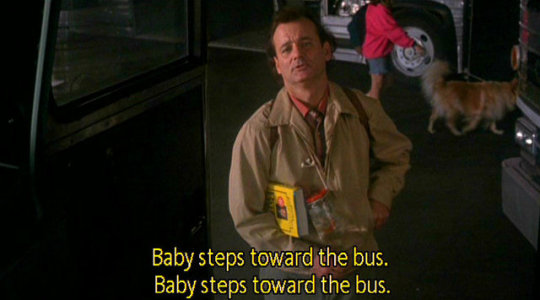
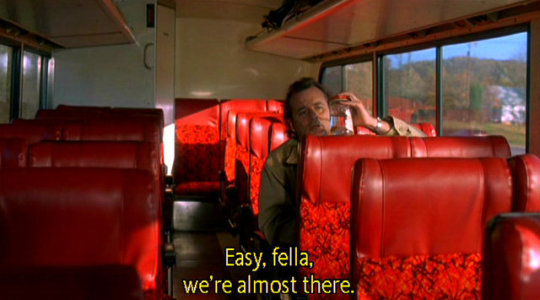
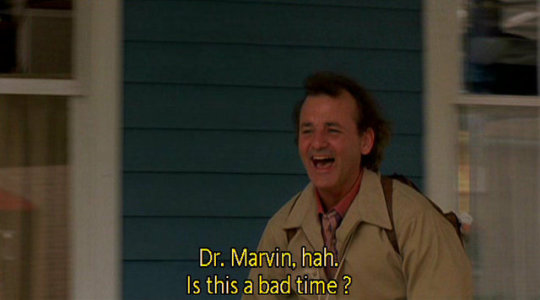
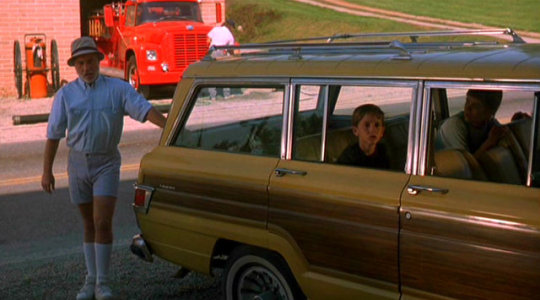


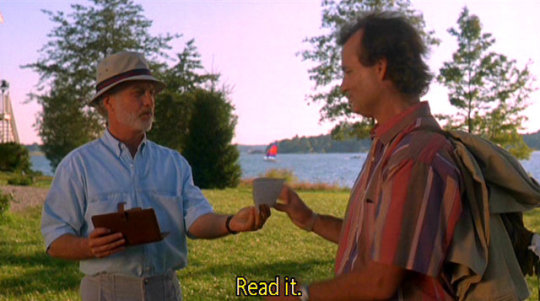



What About Bob?
#What About Bob?#Frank Oz#Alvin Sargent#Laura Ziskin#Tom Schulman#Kathryn Erbe#Charlie Korsmo#Richard Dreyfuss#Bill Murray#What About Bob
24 notes
·
View notes
Photo

Ava DuVernay to Receive Producers Guild’s Visionary Award
The Producers Guild of America has selected Ava DuVernay as the recipient of its 2018 visionary award.
DuVernay will be presented the award at the 29th Annual Producers Guild Awards on Jan. 20 at the Beverly Hilton Hotel. The award recognizes producers for “their unique or uplifting contributions to our culture through inspiring storytelling or performance.”
The PGA said DuVernay is being honored for her work in creating topical films and television shows focusing on important social issues, such as “13th,” the documentary about race in America for which she earned two Emmys and an Academy Award nomination, as well as her series “Queen Sugar.” In 2010, she founded Array, a non-profit collective for distribution and amplification of films by people of color and female filmmakers.
DuVernay was the first African-American female director to have a film nominated for best picture at the Academy Awards with 2014’s “Selma” and the first to win the best director prize at the Sundance Film Festival for 2012’s “Middle of Nowhere.” Her upcoming film, “A Wrinkle in Time,” makes her the first African-American woman to helm a film budgeted at more than $100 million.
Producers Guild Awards Chairs Donald De Line and Amy Pascal said, “The emergence of Ava DuVernay as a producer and filmmaker has been one of the great developments of the past several years. Whether in scripted features, television, or documentaries, her unique voice, skill, and passion have inspired countless audiences throughout our country and around the world. She is, by any standard, a visionary storyteller, and we are excited to be honoring her as such in 2018.”
Previous honorees include Annapurna Pictures founder Megan Ellison; Brad Pitt, Dede Gardner, and Jeremy Kleiner’s Plan B Entertainment; Illumination Entertainment’s Chris Meledandri; producer Laura Ziskin; and Participant Media’s Jeff Skoll.
Dave McNary
December 7, 2017 9:30AM PST
11 notes
·
View notes